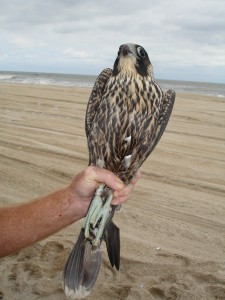The Deepwater Horizon Oil Spill (DWH) released an estimated 5 million barrels of oil into the Gulf of Mexico during April through July 2010. Earthspan and its partners, The Peregrine Fund and the University of Connecticut, collected and analyzed blood samples from migrating Peregrine Falcons at South Padre Island (TX) and Assateague Island (MD) to measure pre and post-spill concentrations of polycyclic aromatic hydrocarbons (PAH) from 2009-2011. PAHs are known to cause a variety of adverse eco-toxicological impacts that include acute toxicity, reproductive failures, DNA adducts, and heritable mutagenesis in offspring. Our collaborative study was published March 2015 in Ecotoxicology. PDF
Abstract: Monitoring internal crude oil exposure can assist the understanding of associated risks and impacts, as well as the effectiveness of restoration efforts. Under the auspices of a long-term monitoring program of Tundra Peregrine Falcons (Falco peregrinus tundrius) at Assateague (Maryland) and South Padre Islands (Texas), we measured the 16 parent (unsubstituted) polycyclic aromatic hydrocarbons (PAHs), priority pollutants identified by the United States Environmental Protection Agency and components of crude oil, in peripheral blood cells of migrating Peregrine Falcons from 2009 to 2011. The study was designed to assess the spatial and temporal trends of crude oil exposure associated with the 2010 Deepwater Horizon (DWH) oil spill which started 20 April 2010 and was capped on 15 July of that year. Basal PAH blood distributions were determined from pre-DWH oil spill (2009) and unaffected reference area sampling. This sentinel species, a predator of shorebirds and seabirds during migration, was potentially exposed to residual oil from the spill in the northern Gulf of Mexico. Results demonstrate an increased incidence (frequency of PAH detection and blood concentrations) of PAH contamination in 2010 fall migrants sampled along the Texas Gulf Coast, declining to near basal levels in 2011. Kaplan–Meier peak mean PAH blood concentration estimates varied with age (Juveniles16.28 ± 1.25, Adults-5.41 ± 1.10 ng/g, wet weight) and PAHs detected, likely attributed to the discussed Tundra Peregrine natural history traits. Increased incidence of fluorene, pyrene and anthracene, with the presence of alkylated PAHs in peregrine blood suggests an additional crude oil source after DWH oil spill. The analyses of PAHs in Peregrine Falcon blood provide a convenient repeatable method, in conjunction with ongoing banding efforts, to monitoring crude oil contamination in this avian predator.
To our knowledge, this is the first field study in which levels of PAHs were measured nondestructively in Peregrine Falcons with the purpose of monitoring oil pollution in the coastal environment after a large oil spill. The analysis of PAHs in Peregrine Falcon blood provides a convenient and relatively rapid method, with little disturbance to birds, for monitoring PAH contamination in their avian food chain. Overall, our study demonstrates the use of peregrine blood as a monitoring tool for oil exposure.

